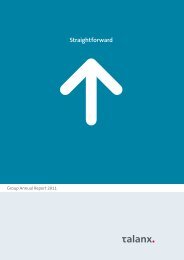Values
Values
Values
You also want an ePaper? Increase the reach of your titles
YUMPU automatically turns print PDFs into web optimized ePapers that Google loves.
98<br />
Group Financial Statements<br />
Notes<br />
Share-Based Payments<br />
Share options are granted to certain directors and senior employees.<br />
Th e options are granted at the market price on the<br />
grant date and are exercisable at that price. No compensation<br />
cost is recognized in the income statement for share options<br />
granted before November 7, 2002. When the options are exercised,<br />
the proceeds received, net of any transaction costs, are<br />
taken directly to equity.<br />
For share options granted after November 7, 2002, the fair<br />
value of the options granted is recognized as personnel costs<br />
with a corresponding increase in equity. Th e fair value is mea-<br />
Non-Current Assets Held for Sale and<br />
Related Liabilities<br />
Non-current assets or disposal groups are carried as being<br />
available for sale if the associated carrying amount is mostly<br />
realized in a disposal transaction and not from continued use.<br />
Th ese non-current assets and the associated liabilities are<br />
presented in separate line items in the balance sheet under<br />
IFRS 5. Th ey are measured at the lower of carrying amount or<br />
fair value less cost to sell. Scheduled depreciation/amortization<br />
is not recorded if a non-current asset is classifi ed as available<br />
for sale or forms part of a disposal group that is classifi ed as<br />
available for sale.<br />
Government Grants<br />
A government grant is not recognized until there is reasonable<br />
assurance that the enterprise will comply with the conditions<br />
attaching to it and that the grant will be received. Grants for<br />
assets are recognized as accrued liabilities and recycled to in-<br />
Estimates and Assumptions<br />
Th e preparation of IFRS-compliant consolidated fi nancial statements<br />
requires the use of estimates and assumptions that may<br />
impact the carrying amounts of assets, liabilities, income and<br />
expenses recognized. Amounts actually realized may diff er from<br />
estimated amounts. Th e following section presents estimates<br />
and assumptions that are material in the Bertelsmann Group<br />
fi nancial statements for understanding the insecurities associated<br />
with fi nancial reporting.<br />
Recognition of Income and Expense: Some Bertelsmann<br />
companies that enter into long-term production contracts with<br />
customers and recognize revenues according to the percentageof-completion<br />
method do have to estimate the degree of completion.<br />
Th is results from the relationship between the contract costs<br />
already incurred by the end of the fi scal year and the estimated<br />
total project costs.<br />
sured at the grant date and allocated over the vesting period<br />
during which the employees become unconditionally entitled<br />
to the options. Th e fair value of the options granted is measured<br />
using a binomial option-pricing model, taking into account<br />
the terms and conditions at which the options were granted.<br />
Th e amount recognized as an expense is adjusted to refl ect the<br />
actual number of share options vesting. Share options forfeited<br />
solely due to share prices not achieving the vesting threshold<br />
are excluded.<br />
Components of entities that fulfi ll the requirements of IFRS 5.32<br />
are classifi ed as discontinued operations and are thus carried<br />
separately in the income statement and cash fl ow statement. All<br />
of the changes in amounts made during the year under review<br />
that are directly connected with the sale of a discontinued operation<br />
in any preceding period are also stated in this separate<br />
category. If a component of an entity is no longer classifi ed as<br />
available for sale, the results of this entity component that was<br />
previously carried under discontinued operations, are reclassifi<br />
ed to continued operations for all of the reporting periods<br />
shown.<br />
come over the expected useful life of the respective asset using<br />
the straight-line method. Performance-related grants are<br />
recognized as income in the periods in which the expenses to<br />
be compensated by the grants were incurred.<br />
In the event of return rights, mostly for print products, estimates<br />
must also be made with regard to the anticipated return<br />
volume, as revenues are recognized taking the anticipated returns<br />
into account. Return ratios determined using statistical<br />
methods are used to identify the anticipated returns.<br />
Inventories, trade receivables and other receivables: Writedowns<br />
are formed for doubtful receivables based on risk factors<br />
such as the customer’s risk of default taking the maturity structure<br />
of the receivables into account.<br />
Sales estimates and assumptions on future sales success are<br />
also made in connection with advances paid to authors to secure<br />
exploitation rights in their publications. In addition, in the<br />
case of sport and fi lm rights, estimates are made with regard to<br />
anticipated revenues.<br />
Bertelsmann Annual Report 2009
















